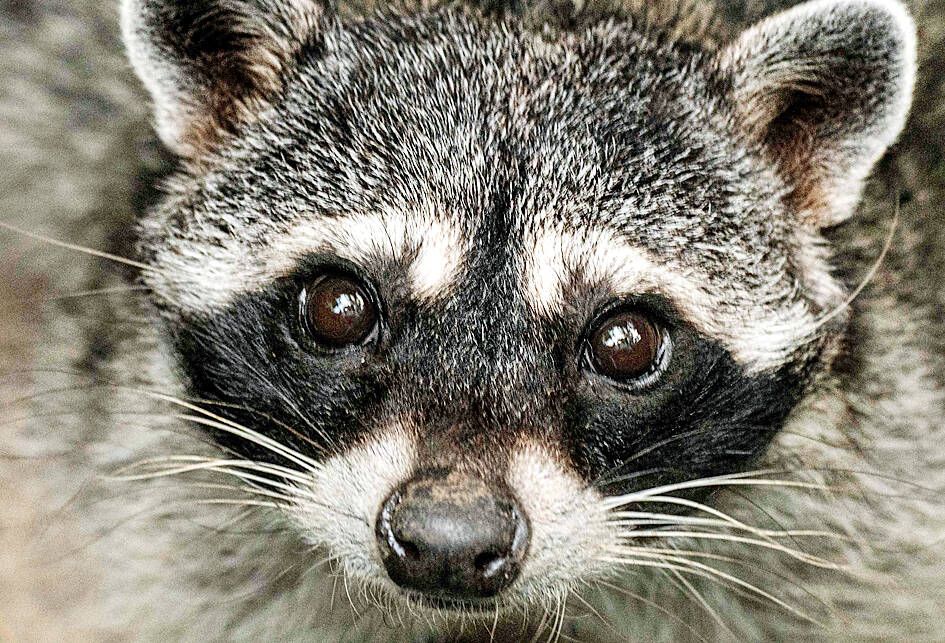Having won the battle to tackle Tokyo’s population of giant, ravenous crows, the city’s authorities are now embroiled in an even tougher campaign — to rein in another animal menace, the North American raccoon.
The number of raccoons caught in the capital every year has increased fivefold over the past decade, according to media reports, amid concern about the damage the animals are inflicting on the local ecosystem.
Municipalities in western Tokyo have responded by setting traps and launching hotlines for residents who spot crop damage or witness the animals entering their homes.

Photo: AFP
The omnivores are not native to Japan, where they are one of 156 species on a Japanese Ministry of the Environment list of invasive alien creatures that also includes black bass, fire ants and snapping turtles.
The raccoon population soared after those that were kept as pets were abandoned or escaped, and then flourished in the wild, the Mainichi Shimbun reported this week.
Their popularity as pets has been attributed to a 1970s TV anime, Rascal the Raccoon, which reportedly led to a surge in imports of the animals.
They are not to be confused with tanuki, or Japanese raccoon dogs, indigenous animals that feature in Japanese folklore and are believed to bring good fortune.
The raccoons are mostly found in hilly areas on the western fringes of metropolitan Tokyo, where they are causing widespread crop damage.
Local authorities are facing an uphill battle to keep raccoon numbers under control — the animals are not only prodigious breeders, they are also quick to adapt to unfamiliar environments.
A total of 1,282 raccoons were caught in Tokyo in the fiscal year ending in April last year, according to the local government, compared with 259 a decade earlier.
The animal’s proliferation is being reflected in the havoc they cause in rural areas, where they caused ¥450 million (US$2.9 million) of damage in fiscal 2022, the Japanese Ministry of Agriculture, Forestry and Fisheries said, adding that fruit and vegetables, and livestock, were the most common targets.
The Mainichi Shimbun also cited reports of raccoons feasting on the endangered Tokyo salamander, officially deemed at risk of extinction as a result of decades of destruction to its natural habitat.
The measures introduced so far appear to have have had little effect.
“Our traps are sometimes broken as raccoons are also desperate to live. Only a fraction of them are actually caught, so we are unable to grasp their overall range,” an official told the Mainichi Shimbun.
The problem is not confined to Tokyo, with complaints about raccoon damage to crops, infrastructure, and private homes and gardens reported in almost all of Japan’s 47 prefectures.
In Niigata, on the Japan Sea coast, raccoon captures have risen sharply since 2018, while in the northernmost prefecture of Hokkaido, where the animals are thought to have established themselves as long ago as the late 1970s, they have been blamed for causing millions of yen of agricultural damage.

Drug lord Jose Adolfo Macias Villamar, alias “Fito,” was Ecuador’s most-wanted fugitive before his arrest on Wednesday, more than a year after he escaped prison from where he commanded the country’s leading criminal gang. The former taxi driver turned crime boss became the prime target of law enforcement early last year after escaping from a prison in the southwestern port of Guayaquil. Ecuadoran President Daniel Noboa’s government released “wanted” posters with images of his face and offered US$1 million for information leading to his capture. In a country plagued by crime, members of Fito’s gang, Los Choneros, have responded with violence, using car

Canada and the EU on Monday signed a defense and security pact as the transatlantic partners seek to better confront Russia, with worries over Washington’s reliability under US President Donald Trump. The deal was announced after a summit in Brussels between Canadian Prime Minister Mark Carney and European Commission President Ursula von der Leyen and European Council President Antonio Costa. “While NATO remains the cornerstone of our collective defense, this partnership will allow us to strengthen our preparedness ... to invest more and to invest smarter,” Costa told a news conference. “It opens new opportunities for companies on both sides of the

The team behind the long-awaited Vera Rubin Observatory in Chile yesterday published their first images, revealing breathtaking views of star-forming regions as well as distant galaxies. More than two decades in the making, the giant US-funded telescope sits perched at the summit of Cerro Pachon in central Chile, where dark skies and dry air provide ideal conditions for observing the cosmos. One of the debut images is a composite of 678 exposures taken over just seven hours, capturing the Trifid Nebula and the Lagoon Nebula — both several thousand light-years from Earth — glowing in vivid pinks against orange-red backdrops. The new image

OVERHAUL: The move would likely mark the end to Voice of America, which was founded in 1942 to counter Nazi propaganda and operated in nearly 50 languages The parent agency of Voice of America (VOA) on Friday said it had issued termination notices to more than 639 more staff, completing an 85 percent decrease in personnel since March and effectively spelling the end of a broadcasting network founded to counter Nazi propaganda. US Agency for Global Media (USAGM) senior advisor Kari Lake said the staff reduction meant 1,400 positions had been eliminated as part of US President Donald Trump’s agenda to cut staffing at the agency to a statutory minimum. “Reduction in Force Termination Notices were sent to 639 employees at USAGM and Voice of America, part of a